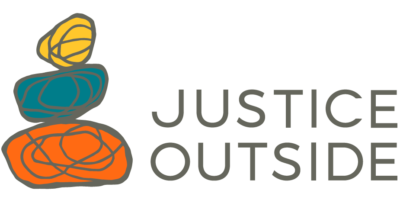Justice Outside has been sharing about the 30×30 initiative to protect 30% of our lands and waters by 2030 in our recent blog series because we want our communities and audiences to be informed and inspired to take action. Our message on 30×30 is clear: Black, Indigenous, and community of color leadership is the only way to achieve the biodiversity and climate goals outlined by 30×30. Moreover, that leadership will promote a diversity of benefits spanning social and environmental priorities through community-led planning and implementation, including healthy landscapes and watersheds, safer coastlines, protected cultural sites, and healthier communities.
We are just getting started working in coalition with strong social and environmental justice allies to help ensure the 30×30 initiative is connected to and led by communities of color. The collective work of Indigenous communities and Tribal Nations, Native Alaskans, communities of color, and U.S. agencies since 30×30 was launched in 2021, has been incredible, including:
- Leadership from Native Alaskan communities resulted in the Biden-Harris administration reviving the Northern Bering Sea Climate Resilience Area. And President Biden restored the boundaries of Bears Ears National Monument, Grand Staircase-Escalante National Monument, and Northeast Canyons and Seamounts National Monument.
- The 30×30 initiative also gained momentum in conserving ecologically- and culturally-significant landscapes from industrial activities, including protecting the Boundary Waters Canoe Area Wilderness in Minnesota from a copper and nickel mine [link to Blog 4] and taking important steps to safeguard the Arctic National Wildlife Refuge from development
- Leadership from Tribal Nations and local communities on key ancestrally-rooted conservation priorities resulted in federal wins, including:
- The Biden-Harris administration took action to end industrial-scale logging of old-growth on Tongass National Forest, began the process to protect the lands around Chaco Culture National Historical Park from drilling, and advanced the proposed Chumash Heritage National Marine Sanctuary.
- Deb Haaland, Secretary of the Interior, led the Biden administration in strengthening the government-to-government relationship by promising meaningful engagement Tribal Nations and U.S. federal agencies in the management – and co-stewardship – of U.S. public lands and waters, especially around the protection of sacred lands, ceremonial sites, and trust and treaty rights.
Even with these strides, we know that there is so much more work to be done. We look forward to doing it alongside our community as we envision a more just and healthy planet for us all.
What’s Happening in 2022
Local leaders, Tribal Nations, farmers and ranchers, hunters and anglers, commercial fisherman, and conservation and community groups have worked hard throughout the last year to develop locally-driven conservation initiatives to meet the 30×30 challenge.
It’s time for the Biden-Harris administration, and federal agencies tasked with implementing the 30×30 workplan to begin building an inclusive and resilient conservation legacy that reflects the diversity of our natural heritage and permanently protects our lands and waters. These popular, community-led efforts are a good place to begin.
- In El Paso, Texas there is a longstanding community effort to protect the mountains of the Castner Range and open the lands to the public. Establishing the proposed Castner Range National Monument would be the first of many efforts by the Biden administration to protect frontline communities and other marginalized people who are disproportionately bearing the brunt of climate impacts through the protection of public lands.
- In Nevada, a coalition of Tribes, local residents, elected leaders, and others are calling for the establishment of the Avi Kwa Ame National Monument. Avi Kwa Ame is the Mojave name for Spirit Mountain, which sits at the center of the Yuman Tribes’ creation story. Establishing Avi Kwa Ame National Monument would be a crucial contribution to the preservation of Native American ancestral lands, joining Bears Ears and Gold Butte national monuments.
Our partners and allies are engaging in incredible advocacy to advance this work. Azul describes conservation of 30% of California’s land and coastal waters as the “minimum level of protection needed to safeguard our natural resources for future generations” and joins a growing movement urgently calling for national and international governments to increase conservation, equity, and access targets to protecting 50% of lands and waters by 2050.
In 2021, the federal administration made some bold goals not only for conservation, but also for equity and access. Now it’s up to us, the environmental justice community, to hold the Biden-Harris administration and the federal government accountable to deliver on those commitments.
We invite you to get involved: Check out this list of Tribes, states, and local governments who have signed on to 30×30. And we welcome you to join us as a member of the The Equitable and Just National Climate Platform.
This blog concludes a series by Justice Outside exploring Indigenous and racial justice inside 30×30. 30×30 is a U.S. and global initiative to protect 30% of our lands and waters by 2030. Justice Outside’s commitment within 30×30 is to ensure that the leadership and voices of Black, Indigenous, and communities of color are at the center of our shared efforts to protect and conserve lands and waters.
View the series:
1] “What is 30×30?”
2] “Why Black, Indigenous, and Communities of Color Should Be At the Center of 30×30 Conservation Efforts”
3] The Role of Indigenous, Racial Justice, and Environmental Justice Groups in the U.S. Federal 30×30 Work Plan
4] What Are the Roles of Justice Outside and Other Environmental Justice Groups in 30×30?
5] What’s Next for 30×30 in the U.S.?
#30×30

